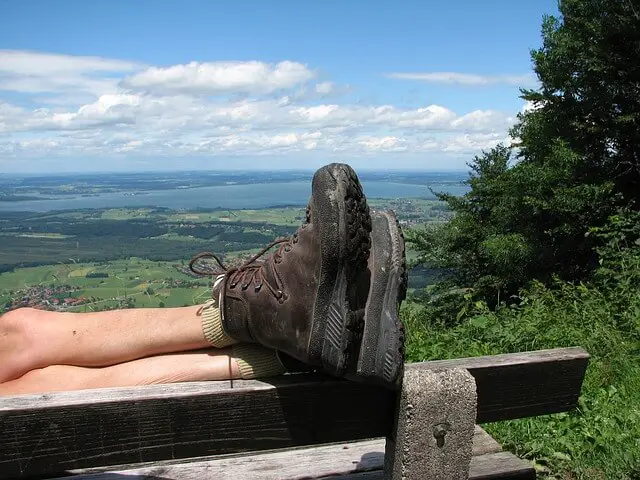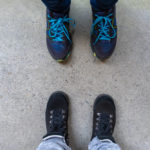Not all hikers have good hiking experiences when they first start hiking. Not having the proper footwear can sometimes make your feet uncomfortable and tired. You might even get blistering and abrasions, and we all know how painful that can be.
Many hikers invest in a good pair of hiking boots, thinking they will be a quick fix for all their feet-related troubles. Still, you will find that even the best hiking boots can sometimes leave your feet sliding forward when walking. This might be because of the shoe itself, or it might be something that you can fix within minutes.
If you want to learn how to keep your feet from sliding forward in your hiking boots, you have come to the right place. This guide will tell you every tip and trick you need to know to make your boots fit like a glove. So, let’s get into the guide and see what you need to do to your shoes to improve the fit!
More...

Table of Contents
Should Your Feet Move-in Hiking Boots?
You might think this is normal if you have always experienced your feet moving in your hiking boots. But this is not the case as your feet should not be moving in the boots. The tighter the fit is, the better for the foot!
If the foot moves around in any shoe, that leaves the door open to injuries. The shoe does not provide enough stability and a tight fit. The foot can move in the wrong way and cause pain in the ball of the foot or even the ankle.
To add, all that are moving in the shoe can also lead to blistering and abrasions. If you are hiking upwards or climbing, sometimes, the feet will move to the back of the shoe and cause the skin to rub against the shoe. The wounds on your feet will take a while to heal, so you will not even be able to continue hiking during that time.
If your foot moves forward in the shoe, it might also cause problems with the toenails. Something called the Hiker’s Toenail can be caused by improperly fitted shoes and is very painful. So, if your feet are moving in your hiking boots, you risk getting this type of injury on your toes.
If there is one thing you can take out from all this, it should be that your feet should not be moving in your hiking boots or any other type of shoe. This is a big no-no because it can only lead to pain and injuries. So, getting shoes that fit well is always the best thing to do!
Why Do Your Feet Slide Forward in Hiking Boots?
There are two obvious reasons your feet could slide forward in hiking boots. From my experience, either the quality of the shoe is questionable, or the shoe is not a good fit for you.
If you are certain the shoe fits you well, you should consider its quality. Do the shoes come with good laces and lace anchors, or do you need to put some other type of laces on them? Whatever the case, use proper lacing techniques to ensure that the problem is not the laces.
Then, check the quality of the sole and the tongue pads, and even consider changing them if needed to improve the fit. Get a high-quality insole that will offer good arch support at all times. This can be an easy way to get a permanent fix without worrying about slippage anymore.
But if the problem is not the inside of the boot, it can be in the boot's fit. Make sure that you have the proper size boot for your feet. Even an inch too long, short, wide, or narrow will cause many problems. If your boots do not fit you well, you better get a new pair, or you will have to constantly deal with slippage.
Several other ways to improve the shoe's fit and keep your foot from sliding around in it. I will mention these methods in greater detail in the section below, so make sure you stick around for that.

How to Keep Your Feet from Sliding Forward in Hiking Boots? - Step-By-Step
Let’s see, you have found that your hiking boots cause pain and discomfort, and it all stems from your feet sliding in the boots. You might think there is no hope for your shoes, but there is!
I want to share six very interesting methods that you can try to stop the sliding that has been going on. All these methods are quick, inexpensive, and should be effective at making your hiking boots fit great. So, let’s get right into the ways and see what they are all about!
Add another pair of socks
If you feel like slipping in your shoes, you should first add another pair of socks. Wearing non-slip socks is always a good idea, and it can be extremely helpful if you are dealing with heel slippage. You do not need to get any special socks - any thicker socks you own will do.
Still, I recommend looking into the special hiking socks as they are more comfortable. There are two kinds of hiking socks. Some are thin and compressed, while the second type is thicker and usually made from wool. Merino wool socks are great, but they can also be a bit expensive.
So, try adding a second layer of socks to see if that might help your problem. If that is not the case, move on to the second method and see if that might help.
Get better insoles
Insoles are very important. Not all shoes come with good insoles, but I always recommend adding ones that will improve your comfort and warmth. If you find that your feet are slipping in your hiking boots, a good insole can be the solution to your problem.
When you get new shoes, the first thing to do is see if their insole makes your arch feel good. On longer trips, your arch can feel strained if it gets no support or comfort from the insole. Your feet will get tired and even distressed, so you must wait for them to recover before heading on another adventure.
This is where the insole comes into the story, as it can immediately fix the comfort and warmth issues. Combined with the non-slip socks mentioned above, the sole will improve your slippage issues.
Consider a tongue pad
Tongue pads are a very convenient way to improve the slippage issues in your shoes. They do not go under the feet like insole pads do but go on under the tongue of the shoe and over the foot. If your feet are slipping because the shoe is too wide, a tongue pad can help you improve the fit significantly.
Many manufacturers create such pads that are suitable for all kinds of enclosed shoes, not only hiking boots. They are affordable and easy to apply to the shoe, so you should have no problem adding them to your shoes. If the shoe is still too wide even with the tongue pad, consider layering your socks and seeing if that will help the situation.
Try various lacing techniques
I mentioned above that the laces could also be causing slippage within the shoe. When buying hiking boots, you should ensure that the boots have durable, thick laces that are laced in the right way. You can use many lacing techniques on your shoes should you not like the original lacing.
There is also the option for you to get some quality laces that you like and add them to the shoes. When lacing them, go for either the heel lock lacing or the surgeon’s knot. Many tutorials online can show you how to do both types of lacing, so do not worry if you do not know how to do them.
Tighten your laces
As important as it is to have good laces, you must also have the laces tightened to perfection. This can be tricky, as you might need to tighten and loosen them up during each trip. It is recommended to have tighter laces when walking downwards, while they should be looser when walking upwards on a mountain or hill.
You should also consider getting some lace anchors as they make adjusting the laces much easier. Make sure that both the lace anchors and the laces are tight. If you have the right boot, changing the lacing alone can make them feel and fit much better on your feet.
Check the size of the boots
I should mention that all methods listed above can be combined to get the fit that you like. Most shoes will not need more than one method to fit correctly – either the lacing or the extra sock makes the difference. Still, if nothing helps the fit, you might need a new pair of shoes.
The next time you buy hiking boots, go to the store and have a professional help you with the fit. Do not buy shoes online as not all manufacturers make shoes that are true to size. It is better to buy them from an actual store and have a professional help you with the proper fit and lacing.
What Is Hiker’s Toenail and Why Should You Be Afraid of It?
All that moving of your foot in your boot can lead to serious injuries like the Hiker’s Toenail. The name does not do it justice – this is quite a serious condition you want to avoid. If you get black toenails after a long hike, you have Hiker’s Toenails.
With boots that do not fit well, there is space enough for the foot to keep bumping into the toe box at the front of the shoe. This will cause distress in the toenail, making it bloody and even black. With time, the only place where this toenail can go is off the foot and into the bin.
If you have not experienced a Hiker’s Toenail before, you do not know how painful it can be to have a toenail rip off your foot. You will have to protect the toe before your new toenail grows; that will not happen overnight. You will also have to protect the skin under the toenail from infections, which means no walking barefoot and no keeping your foot in a shoe for extended periods.
Hiker’s Toenail is something you should fear and dread, as I do not wish anyone to go through that pain. My recommendation is to protect the toes and the feet as a whole during your hiking trips, especially the longer and more demanding ones. Also, make sure that you cut your toenails short before each trip. This will help you avoid Hiker’s toenails and save you a lot of pain.
Wrap-Up
Thank you for sticking with me through this guide on all things hiking boots and feet! I hope you learned the dangers of having improperly fitted hiking shoes and unprotected feet. While in some cases you will need to invest in a new pair of shoes, I recommend that you try the methods I gave you above first and then decide if you need to get new hiking shoes or not.
Do you know any other fitting methods that can fix heel slippage and keep your feet from sliding forward? I would love to know about them, so do not hesitate to share your techniques in the comments below. The other readers and I will appreciate your input on this topic!
- Are Merrell Shoes Good? – An Unbiased Review of Merrell Footwear - December 9, 2023
- Where Are Merrell Shoes Made? - December 9, 2023
- Camping in 40-degree Weather: Tips and Tricks - September 25, 2023


![Is Hiking Bad for Your Knees? [Best Ways To Protect Your Knees] Is Hiking Bad for Your Knees? [Best Ways To Protect Your Knees]](https://grandcircletrails.com/wp-content/uploads/2022/12/is-hiking-bad-for-your-knees-150x150.jpg)



![Are Hiking Boots Good For Snow? [Everything You Need To Know] Are Hiking Boots Good For Snow? [Everything You Need To Know]](https://grandcircletrails.com/wp-content/uploads/2021/11/Are-Hiking-Boots-Good-For-Snow-1-150x150.jpg)